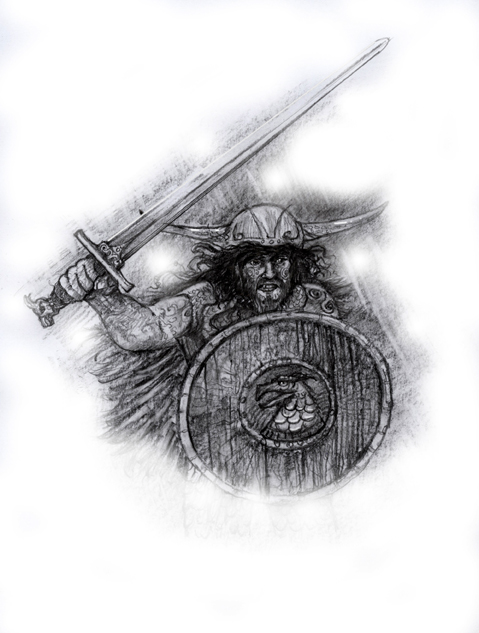Okay, so I’ve already discussed two origins for the fantasy arena: history and myth, or histology as I shall call it. Today I want to delve deeper, and if you don’t mind, being of Celt and Saxon stock, I’ll focus on the British Isles, my homeland.
I have mentioned the Mabinogian, or Mabinogi before. These are old Welsh fables. Just how old they are is impossible to fathom, though I suspect their first echoes long predate the Fall of Rome. The Mabinogi describes the British mainland as ‘The Island of The Mighty’, and hints at a dark future when yellow-haired savages invade from across the sea, destroying all in their path – a violent roving crowd who eventually morphed into the English.
Before understanding the richness and many strands comprising the histology of Dark Age Britain, it helps to know where its folk originated from. For example, those first English invaders stemmed mostly from three races: the Jutes, from Jutland Denmark, the Saxons, from northern Germany, and the Angles, from the lands in between. This last group being responsible for the name, England (Angleland).
Much like the Vikings hundreds of years later, these Teutonic invaders were warlike folk seeking land, fortune, and an easier life. Post Roman Britain was rumoured wealthy and had much to offer. According to myth two chieftains, Hengist and Horsa were invited over by a weak British ruler, Vortigern, who was having trouble with both the Picts and the Irish. Hengist and co arrived, were usful for a time, but then started giving this Vortigern more headaches than ever before.
Trouble was these Germanic/Danish mercenaries found Britain quite a comfortable place to hang out. So they invited their cousins over and took up permanent residency on the Isle of Thanet in Kent. From that island base they raided and invaded, and for generations after the bloody wars between the Prydain Celts (British) and Germanic/Scandanavian (English) raged through the Home Counties and beyond.
About this time arose the legend of King Arthur and those wonderful tales surrounding him and his knights, and the magician Merlin (Myrddyn) romanticized by Geoffrey of Monmouth and later Sir Thomas Malory – the latter introducing the round table and calling the warriors ‘English Knights.’ The truth was they were Celtic freedom fighters struggling to halt the English incursion. But the stories – as is so often so – were kidnapped by those holding power, the Plantagenet kings of medieval England and their descendents. Arthur (if he existed at all) was no English hero and certainly not a king, but rather a Celtic warlord leading the dark age fight against those early English invaders. So who then were the Celts?
The Celts were Indo Europeans who had travelled west from central Asia and settled in western Europe. They dwelt in France (mainly Brittany), Spain (Galicia), Britain and Ireland. They were a loose federation of warlike tribes. But though feisty and warlike, the Celts had a rich strong culture and were natural traders. That said they didn’t always get on, part of the reason why the English took hold.
The Irish Celts lived in Eire’s three realms, Connaught, Munster and Leinster, and also in Ulster up in the rugged north. Free from Roman and Saxon invasion, Ireland flourished until the early Norse invaders, and soon after that the commencement of the ‘Troubles,’ when Henry FitzEmpress and his Norman nobles arrived to subjugate the Irish people into becoming part of Henry Plantagenet’s empire.
The Scottish were named after an Ulster tribe called the Scotti. This lot settled in Dalriada (Argyle), and clashed with another Celtic group, the original occupants of that northern land. These were the Picts, (painted folk) – named for the woad and blue dye covering their bodies. The Picts left their mark but faded from view as the early Scots kings rose to bloody power, and thus Scotland the Brave was born
The Welsh. The name Welsh (wealas) derived from the Anglo-Saxon name for foreigner, a touch ironic and insulting considering these were the native inhabitants. After the brutal and treacherous centuries following the arrival of Hengist and his pals, those Celts living in what we now call England were forced into the far western regions: Wales, Cornwall, and Cumbria in the Lake District. Two of these areas remain Celtic to this day, Wales (Cymru) and Cornwall, (Kernow) both proudly hold on to their distinct culture and languages. Meanwhile back east the newcomers had settled in, forming the mini Kingdoms of Northumbria, Mercia, East Anglia and Wessex, all of which would combine into England after the days of King Alfred the Great. By then the squabbling Saxons, Jutes and Angles had a new enemy, a threat that united them after years of mutual distrust. The Vikings.
The legacy of this combination of cultures was to award the British Isles with a rich vibrant histology, drawing its sources from not only colourful Celtic myth: The Children of Lyr – Wales, The legend of Cuchulain – Ireland, Tristan and Iseult, Cornwall, but also from Teutonic folklore and legend. The story of Beowulf being a classic example. The Germanic gods, Tiu, Woden and Thunor (Norse equivalents, Tyr, Odin and Thor) left their mark in our days of the week, Tuesday, Wednesday and Thursday.
And talking about Thursday… it’s already here!
Next week we shed murky light the dubious past of Corin an Fol. Good night, J.W.W.


